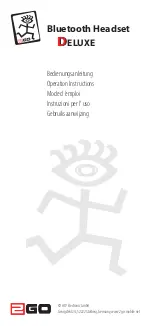
36
english
Jabra PrO 9460, 9460-DuO, 9465-DuO anD 9470 user manual
to go from headset to desk-phone handset:
1. lift the handset to your ear.
2. Do one of the following:
- If you are using a traditional phone without a headset button or electronic hookswitch, then close the audio
connection to your headset by tapping the headset multifunction button, docking the headset in its cradle
on the Jabra PrO base or touching the close-connection icon on the base touchscreen. (this applies also if
you are using a gn1000 handset lifter.)
- If your desk phone has a dedicated headset port and/or electronic hookswitch, then please see your desk-phone
documentation for details. In some cases, you must press a button on your desk phone, while in others it will
be automatic. also, some solutions may terminate the connection if you close the audio link to the headset
(e.g., by tapping its multifunction button or docking it in its charge cradle), while others may require you to
do this before you can speak on the handset. experiment to find out what works best for you.
Softphones
for softphones, your headset is likely to be your only option, but if other audio devices are connected to your
PC, you may be able to switch to them by changing the audio preferences for windows and/or your softphone
program.
Mobile Phones
for mobile phones (Jabra PrO 9465-Duo and 9470 only), the procedure varies by phone model. Please see your
mobile phone documentation for details.
laSt nuMBeR Redial
6.8
Jabra PrO is able to send a redial command to the current target phone. this feature requires that the target
phone supports the redial command; check your phones’ documentation for details.
to use last-number redial with a phone that supports it:
1. If necessary, set the appropriate phone as the current target for your headset (see also
Section 6.2: The Target
Phone Concept.
)
2.
Double-tap
the headset’s multifunction button. Jabra PrO sends the redial command to the selected target
phone and opens the audio link.
Managing call colliSionS and call waiting
6.9
Call collision and call waiting both refer to situations in which you are already on the phone when another call
comes in.
- Call Collision
Occurs when you are talking on one phone and a call comes in on a different phone that is also connected to
your headset. the headset informs you that the collision occurred by playing the ringtone associated with the
incoming phone and updating the touchscreen, but it is not able to place calls on hold. you must therefore
choose to answer the new call (thus terminating your current call) or to ignore the new call. see
Section 8.6:
Managing Call Collision
for complete details.
- Call waiting
enables you to place a current call on hold to answer another call coming in (or on hold)
on the same phone
.
this feature is available only for selected softphones and mobile phones. for mobile phones this feature
depends on your network operator and subscription type. see
Section 8.7: Managing Call Waiting
for complete
details about how to manage call waiting.
liStening to MuSic
6.10
to listen to music from your PC, use the Jabra Control Center and/or its icon in the windows notification area to
open the audio link from the PC to the Jabra PrO base. Provided no other phone lines are active, your headset
will then begin to play all of the sounds generated by your PC, including music from your media player. see also
the Jabra PC suite online help for details.
to listen to music from a mobile phone, use the controls provided by your phone as described in its user manual.
note also the following:
- music sounds best when you use wideband audio when possible. see
Section 8.11: Narrowband vs. Wideband
Audio
.
- If you are using a supported media player and softphone on your PC, then the Jabra softphone driver will
automatically pause the music when a call comes in. you must manually restart the music, however.
















































